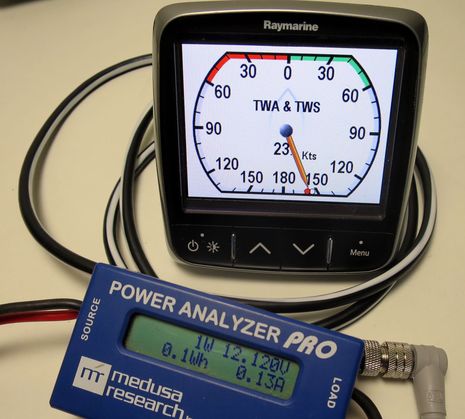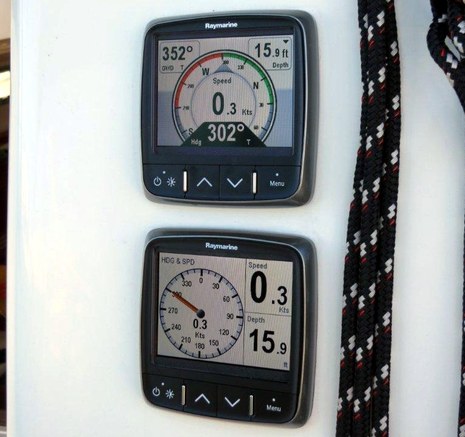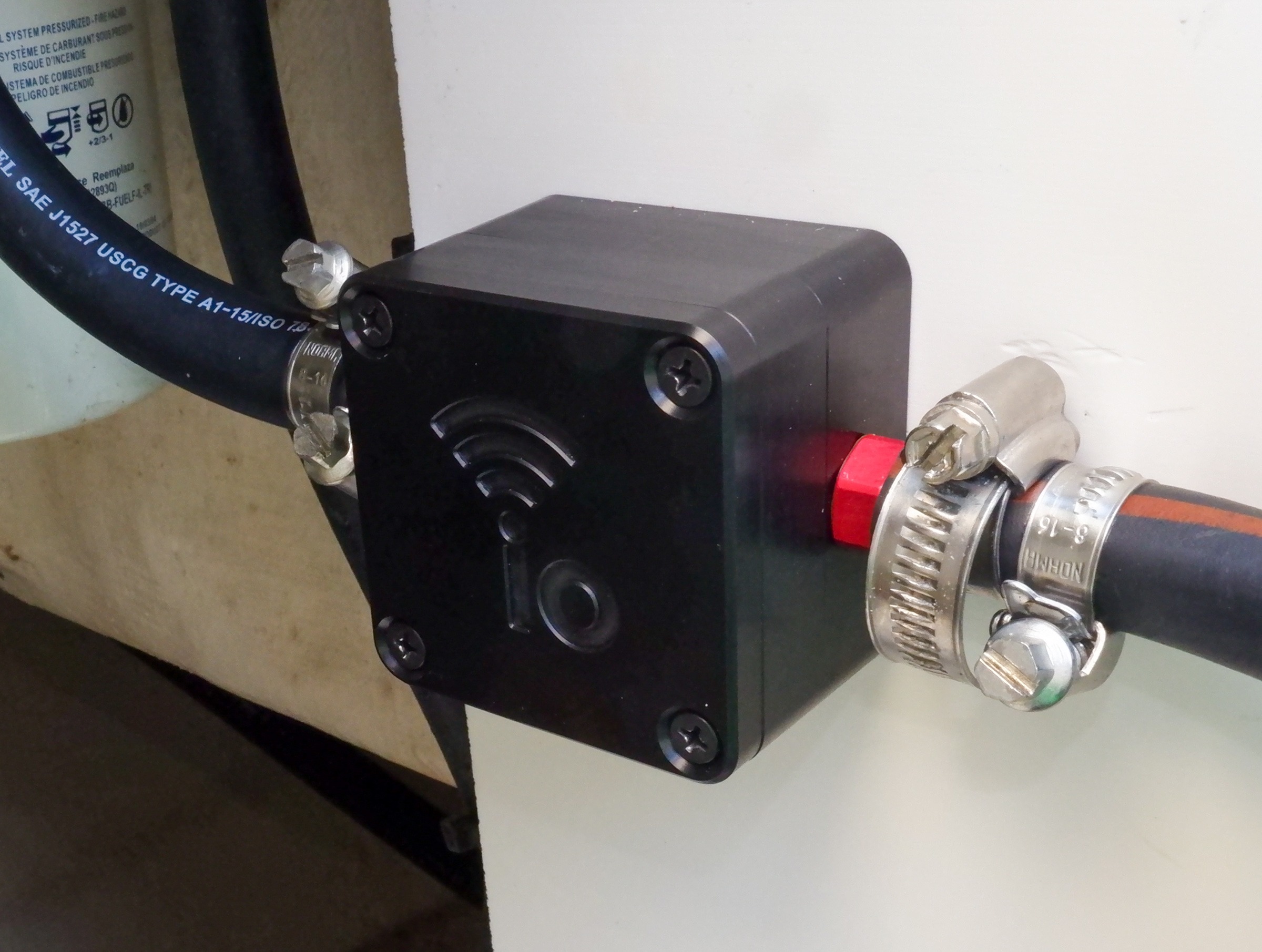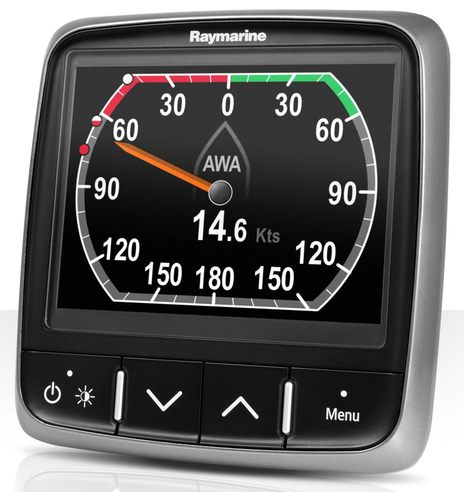NMEA 2000 color instrument power testing, looks good
 When Garmin recently introduced GNX20/21 displays, it led to questions about the power needs of similar but all-color NMEA 2000 instruments. And that led me to finally make up a special N2K cable that I can use with my trusty Power Analyzer Pro to measure the 12 volt current flow to an individual N2K-powered device. So what you’re seeing above is that a Raymarine i70 working with live data at 100% brightness level is using 0.13 amps. That’s not much by most standards, but dropping down a hair to 90% brightness reduced the power draw 20%…
When Garmin recently introduced GNX20/21 displays, it led to questions about the power needs of similar but all-color NMEA 2000 instruments. And that led me to finally make up a special N2K cable that I can use with my trusty Power Analyzer Pro to measure the 12 volt current flow to an individual N2K-powered device. So what you’re seeing above is that a Raymarine i70 working with live data at 100% brightness level is using 0.13 amps. That’s not much by most standards, but dropping down a hair to 90% brightness reduced the power draw 20%…
I got into this testing, trying all the NMEA 2000 displays above at almost every brightness level they offer. The Maretron only has 3 brightness levels, the Garmin GMI20 is unique for 5% increments, and I took an educated stab at balancing the Furuno RD33’s separate screen and keypad backlight (you only need help seeing the keys when the screen is quite dim). As you’ll see in the results table below, all of the displays use significantly less power at slightly less than maximum brightness with power savings declining to almost zero as you dim them way down. I’ve seen similar results with large, individually-powered multifunction displays, though of course, the amperage saving increment is larger. It’s great that marine screens have gotten so bright and readable, but if you’re sailing or at anchor, it’s power smart to keep displays turned down a notch or two. Interestingly, it made no power draw difference to invert colors — all that bright white to black — or to use red themed night colors.
What doesn’t show in the table, though, is the huge difference between all the color screens and the Simrad IS20 representing monochrome technology. In my fairly well-lit lab, the color screens became unreadable somewhere below 50% brightness, but I could not detect the backlighting on the IS20 screen at all. In other words, a sailor can watch a monochrome screen all day for about 0.04 amps an hour, while a similar size color screen might need 90% brightness using twice the power. That’s why Garmin came up with the GNX series, though for many boaters all those relatively low amperage readings are good news. Please note that this is not a definitive test of display efficiency; I don’t have any way of measuring comparative screen brightness levels — though they all look good — and the power increments are so small that accuracy is dubious.
In fact, even the small scale Power Analyzer declines to measure tenths of a watt, which is why I used the amperage figures (while trying to keep the voltage steady at about 12.4). But as a testing bonus, I got to try the gray Posi-Twist wire connectors seen below. The Posi-Lock company also makes Posi-Tite waterproof inline connectors — which were suggested when I revealed my infatuation with Scotch-Loks, especially for splicing thin wires — but the Posi-Twist is more like a much-improved wire nut. They probably make the ABYC cringe, but I felt like that two-piece collar and cone design really clamped down on the twisted fine gauge wires (note that the packaging specifies use for 18-26 gauge, though the shop online listing says 20-24). They’re much faster and easier to use on skinny wires than a conventional crimp and shrink connector, and with a dab of waterproof gel and some strain relief might hold up as long. I will definitely try the Posi-Tite connectors I also purchased.

















Having recently purchased B&G Triton and Maretron DSM150 instruments, your testing is appreciated.
The Maretron DSM150 backlight is the most adjustable, you just need to configure the three backlight presets. If you explore the menus, you should be able to find the settings.
Ben, as always, I really appreciate the great service you do us sailors through your blog.
But this time, I have a small criticism. You used the phrase “…for about 0.04 amps an hour.” That is, of course, a measurement of acceleration, not one of velocity. An amp is a kind of velocity (one amp = one coulomb per second, IIRC), so one amp per hour would be an acceleration that would start at some base rate (e.g., one coulomb per second) and then increase each hour by one additional amp (two coulombs per second, three, four, etc.). “Amps per hour” is a lot like knots per hour.
I know that you know this and this example is nothing more than a typo, but too many people use the term “amps per hour” seriously and it makes it very difficult to understand what they’re trying to communicate.
Ben, nice little test… until I got to the end with the wire nutty twisty things. Please let me talk you in from the ledge!
Its truly remarkable how efficient these colors displays have become!
As to the connectors, I marvel at peoples’ ingenuity creating better mousetraps. While I personally prefer crimp connectors made with the right tools and size connectors (see compass marine), I think the Posi-Lock connectors are a great option for lots of people, especially those who routinely use pliers or inexpensive crimpers.
Cheers
Don
Thanks, Steve! I can’t believe I’ve never noticed that neat back-light configuration option. Maretron also noticed my mistake, and gave me amperage numbers to fill out the revised table above. I totally trust their numbers because they are slightly worse than what I guesstimated, and because Maretron is run by engineers who have a hard time be anything but precise 😉
Thanks, Sheltie, but I may know much less than you realize. I can’t, for instance, comprehend your thoughts on amperage acceleration, velocity. and “coulombs”.
But let me make another try. I believe that there’s a known value called an Amp Hour, which is how we measure the capacity and health of our battery banks. I further believe that a device that uses 0.04 amps in real time also depletes a battery bank 0.04 amps hours. Am I confused?
Hi Ben – great test! Much better than what I would have done if I had done it (but I was having waaay too much fun stripping the varnish off the wheel).
Current drain in amps is just that – drain over time comes out as “amp hours” i.e., amps times hours. We only need concern ourselves when we know how much time is involved – for example, an LED anchor light that draws .4 amps is on for 9 hours per night = 9 X .4 = 3.6 amp hours, which is how much energy was drained from the battery in one night. So your .04 amp drain display drains your battery .04 X however many hours it’s on – measured in amp hours..:-) It would deplete the battery .04 amp hours – in one hour — and .4 amp hours in 10 hours.
Great article Ben! Now I’m curious what some of the newer MFDs draw at different backlighting levels.. and even more interested in what prior generation devices (some non-NMEA2000) like the ST70 and ST60 draw. It would be interesting to see if new vs old with regards to power draw would be a reason to upgrade. The ST60s, for example, aren’t even graphic units, but they have a non-LED backlight. And the ST70 was one of the first all graphic devices for the mass market so out would be interesting to see what progress they’ve made. I know it’s a completely different test setup, but if you ever feel so inclined!
So I made some crude measurements of power consumption on my Raymarine E80 classic 8″ MFD (installed 2007). I used a handheld Hall effect type amp meter (most awesome tool on the planet – everybody should get one – i measured everything on the boat – MFD, lights, fridge, AP, alternator output at various RPMs, etc.).
So the E80 was my most interesting measurement. When powered up, it draws 4 amps (radar on *standby* and screen full bright). Turning the radar OFF (which is diff than standby) drops power consumption to something like 2.5 amps (going from memory). Then turning down the screen only slightly gets me to 1.2 amps. Turning down brightness a lot gets it down to 0.8 amps. When sailing 24 hours a day, I’m basically saving 70+ amp hours a day, which saves me an *HOUR* of engine running each day while offshore. Killer.
On another surprising measurement, I installed a new Alpine stereo on the boat (only using built in amp). Consumption when playing at modest volume powering 4 speakers is like 1 amp (about what I expected). However, when the unit is OFF but the ignition wire is hot (as it typically is 24 hours a day on a boat installation) the unit still draws 0.25 amps. Ugh! So the new stupid stereo now draws as much when its off as two of the color displays above.
If I had to guess, I would bet most boat owners would be surprised where they are leaking amps on their boat. Bad diodes on an alternator? Poorly designed electronics? Inefficient fans (my engine blower sucks 5 amps while running!). I’ve even had one battery in a 6 battery bank get a partial internal short that drew 10 or 20 amps out of the bank (I never would have found that if one of the batteries wan’t warmer than the rest – but i didn’t have the clamp on amp meter back then).
This is the meter I’ve been using:
http://www.extech.com/instruments/product.asp?catid=26&prodid=83
Thanks, Haven! A magnetron radar in standby mode can really consume juice, so it’s great that Raymarine has long let users turn it completely off from their MFDs. Simrad has the same feature, but it’s not very important if you have one of their Broadband Radars. As for Furuno and Garmin, power sensitive sailors should probably wire the radar power with a separate switch.
Incidentally, measuring your Raymarine with an Extech meter was all in the family; both companies belong to FLIR.
Ben–I see you are a fan of Anderson PowerPole connectors. They’re great for distribution of 12-Volt power on a bench.
Excellent Ben, thank you.
Looks like the Triton does well within the color models.
Thanks for the reply, Ben. Hartley has already answered the primary question, so I’ll limit my response to peripheral issues.
A coulomb is a specific amount of electrical charge, (approximately) equal to the charge of approximately 6.241×(10^18) electrons. More specifically, it is the amount of charge transported by a current of one ampere in one second. Thus, an amp (ampere) is a current of one coulomb per second.
The term “amp per second” is thus equivalent to “coulomb per second per second”, which is a measure of how rapidly the coulomb-per-second is changing, meaning how rapidly the current is changing, and is thus analogous to acceleration.
Clear as mud?
Jim
Chris wrote: The ST60s, for example, aren’t even graphic units, but they have a non-LED backlight.
Actually, ST60s have green LED backlight (according to the schematic and the Multi I took apart).
For what it’s worth, I did some testing a while ago for someone on Sailnet (are we allowed to mention that here?):
My spare ST60+ Wind, instrument alone (no masthead unit connected) on a lab supply on my workbench consumes:
Backlight level 0 (off):
51 mA at 10.0 VDC
58 mA at 12.5 VDC
65 mA at 15.0 VDC
And at 12.5V, the various lighting levels increase the draw as follows:
L0 58 mA
L1 74 mA
L2 80 mA
L3 106 mA
The Wind instrument does have a servo/stepper motor to turn the pointer, so it may draw more than a different instrument, then again the Depth or Tridata have the sounder which generates a fairly energetic pulse).
Another caveat – in the “old days” Ohms law applied, and things looked much like resistive loads, in that with higher voltage applied, more current flows. New stuff with step-down switching power supplies often behave the opposite – they draw fairly constant *power*, so input current actually decreases as supply voltage goes up (and typically over a wider input range).
Perfectly fine to reference SailNet here, Redline. Also fine to post links to threads there. Just put the URL in your comment with a space on either side and it will become a link when the comment is posted. The goal is helping each other learn stuff 😉